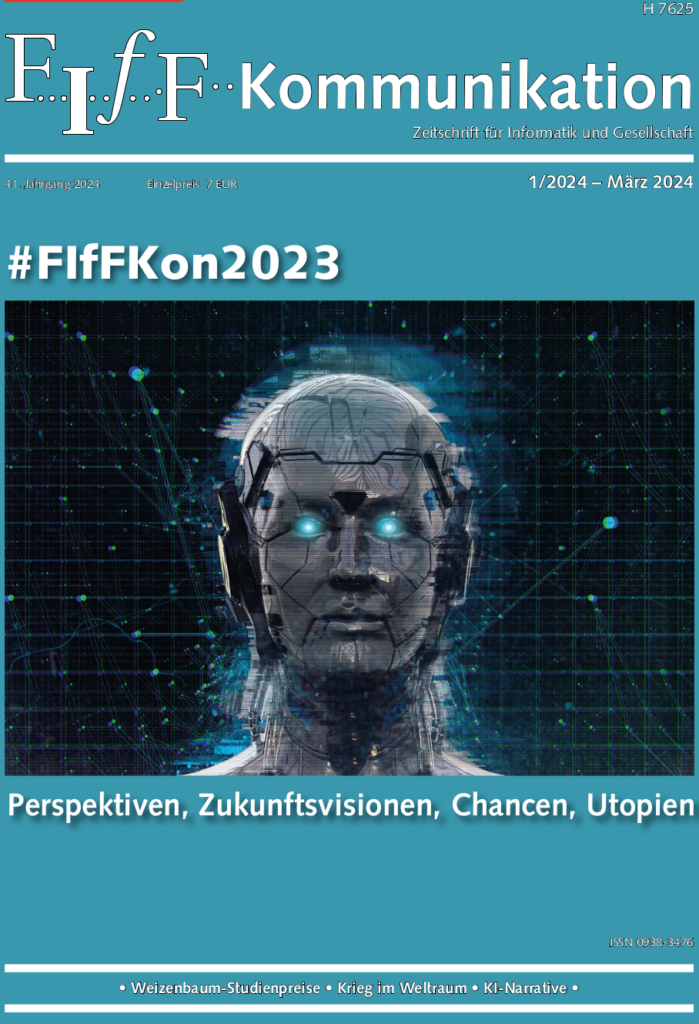A technically generated reality of war | Aesthetic approaches to cyber peace work
Aesthetic approaches to cyber peace work
Lisa Reutelsterz, Leon-Etienne Kühr, Benita Martis, Christian Heck, „Aesthetic approaches to cyber peace work“, in FIfF-Kommunikation 1/2024 “Perspektiven, Zukunftsvisionen, Chancen, Utopien”, Hrsg. Forum InformatikerInnen für Frieden und gesellschaftliche Verantwortung (FIfF) e.V. (Bremen: 2024).
The more powerful and active technical images intervene in our everyday lives, the more central the question of a civil society recapturing the sovereignty of interpretation over these images becomes. With the increasing integration of social values into technology, the ethical challenges arising from the increasing fusion of man and machine are growing. The underrepresented role of aesthetics in cyberpeace work is explored in order to open up a new space for critical debate.
Je wirkmächtiger und aktiver technische Bilder in unseren Lebensalltag eingreifen, desto zentraler stellt sich die Frage nach einer zivilgesellschaftlichen Rück-Eroberung der Deutungshoheit über diese Bilder. Mit zunehmender Integration gesellschaftlicher Werte in Technologie wachsen die ethischen Herausforderungen, die sich aus der zunehmenden Verschmelzung von Mensch und Maschine ergeben. Vorgestellt wird die bisweilen unterrepräsentierte Rolle der Ästhetik in der Friedensarbeit im Cyberraum zur Eröffnung eines neuen kritischen Debattierraums.
Download the article: as PDF (in german language)
Eine technisch erzeugte Kriegswirklichkeit / A technically generated reality of war
Christian Heck, „Eine technisch erzeugte Kriegswirklichkeit“, in FIfF-Kommunikation 1/2024 “Perspektiven, Zukunftsvisionen, Chancen, Utopien”, Hrsg. Forum InformatikerInnen für Frieden und gesellschaftliche Verantwortung (FIfF) e.V. (Bremen: 2024).
Intelligence – Artificiality – Sense Making
Download the article: as PDF (in german language)
Cyber Peace Works
Benita Martis, Ting-Chun Liu, Conrad Weise, Kjell Wistoff, Lisa Reutelsterz, Leon-Etienne Kühr, Pedro A. Ramirez, Bidisha Das, Naoto Hieda, Anton Linus Jehle, „Cyber Peace Works“, in FIfF-Kommunikation 1/2024 “Perspektiven, Zukunftsvisionen, Chancen, Utopien”, Hrsg. Forum InformatikerInnen für Frieden und gesellschaftliche Verantwortung (FIfF) e.V. (Bremen: 2024).
How to explain something whose main component is code? The symbol grounding. Something that cannot be shown, because it is rather a way of thinking. A thinking about abstract signs and symbolic representations. Equal to an access to reality that is not bound to a specific place or a thing that you can’t grab to be able to look at it from different perspectives. Something that takes place on the web. Under the surface of society. Something that is in our ideas as well as in the machines.
Wie kann man etwas erklären, dessen Hauptbestandteil Code ist? The symbol grounding. Etwas, das man nicht zeigen kann, weil es eher eine Art des Denkens ist. Ein Denken über abstrakte Zeichen und symbolischen Repräsentationen. Gleich einem Zugang zur Realität, der nicht an einen bestimmten Ort gebunden ist oder einem Ding, das man nicht greifen kann, um es aus verschiedenen Perspektiven betrachten zu können. Etwas, das sich im Netz abspielt. Unter der Oberfläche der Gesellschaft. Etwas, das sowohl in unseren Ideen als auch in den Maschinen steckt.
Download the article: as PDF (in german language)

The critical computer magazine FIfF-Kommunikation is a journal and newsletter of the Forum InformatikerInnen für Frieden und gesellschaftliche Verantwortung (FIfF) e.V. It is published quarterly with changing topics in the field of computer science and society. The articles are intended to stimulate discussion among computer science experts and to inform the interested public.
